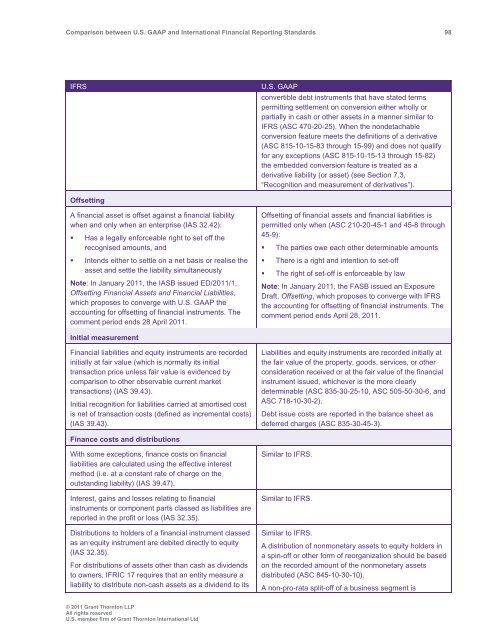Comparison between U.S. GAAP and International ... - Grant Thornton
Comparison between U.S. GAAP and International ... - Grant Thornton
Comparison between U.S. GAAP and International ... - Grant Thornton
Create successful ePaper yourself
Turn your PDF publications into a flip-book with our unique Google optimized e-Paper software.
<strong>Comparison</strong> <strong>between</strong> U.S. <strong>GAAP</strong> <strong>and</strong> <strong>International</strong> Financial Reporting St<strong>and</strong>ards 98<br />
IFRS<br />
U.S. <strong>GAAP</strong><br />
convertible debt instruments that have stated terms<br />
permitting settlement on conversion either wholly or<br />
partially in cash or other assets in a manner similar to<br />
IFRS (ASC 470-20-25). When the nondetachable<br />
conversion feature meets the definitions of a derivative<br />
(ASC 815-10-15-83 through 15-99) <strong>and</strong> does not qualify<br />
for any exceptions (ASC 815-10-15-13 through 15-82)<br />
the embedded conversion feature is treated as a<br />
derivative liability (or asset) (see Section 7.3,<br />
“Recognition <strong>and</strong> measurement of derivatives”).<br />
Offsetting<br />
A financial asset is offset against a financial liability<br />
when <strong>and</strong> only when an enterprise (IAS 32.42):<br />
• Has a legally enforceable right to set off the<br />
recognised amounts, <strong>and</strong><br />
• Intends either to settle on a net basis or realise the<br />
asset <strong>and</strong> settle the liability simultaneously<br />
Note: In January 2011, the IASB issued ED/2011/1,<br />
Offsetting Financial Assets <strong>and</strong> Financial Liabilities,<br />
which proposes to converge with U.S. <strong>GAAP</strong> the<br />
accounting for offsetting of financial instruments. The<br />
comment period ends 28 April 2011.<br />
Offsetting of financial assets <strong>and</strong> financial liabilities is<br />
permitted only when (ASC 210-20-45-1 <strong>and</strong> 45-8 through<br />
45-9):<br />
• The parties owe each other determinable amounts<br />
• There is a right <strong>and</strong> intention to set-off<br />
• The right of set-off is enforceable by law<br />
Note: In January 2011, the FASB issued an Exposure<br />
Draft, Offsetting, which proposes to converge with IFRS<br />
the accounting for offsetting of financial instruments. The<br />
comment period ends April 28, 2011.<br />
Initial measurement<br />
Financial liabilities <strong>and</strong> equity instruments are recorded<br />
initially at fair value (which is normally its initial<br />
transaction price unless fair value is evidenced by<br />
comparison to other observable current market<br />
transactions) (IAS 39.43).<br />
Initial recognition for liabilities carried at amortised cost<br />
is net of transaction costs (defined as incremental costs)<br />
(IAS 39.43).<br />
Liabilities <strong>and</strong> equity instruments are recorded initially at<br />
the fair value of the property, goods, services, or other<br />
consideration received or at the fair value of the financial<br />
instrument issued, whichever is the more clearly<br />
determinable (ASC 835-30-25-10, ASC 505-50-30-6, <strong>and</strong><br />
ASC 718-10-30-2).<br />
Debt issue costs are reported in the balance sheet as<br />
deferred charges (ASC 835-30-45-3).<br />
Finance costs <strong>and</strong> distributions<br />
With some exceptions, finance costs on financial<br />
liabilities are calculated using the effective interest<br />
method (i.e. at a constant rate of charge on the<br />
outst<strong>and</strong>ing liability) (IAS 39.47).<br />
Interest, gains <strong>and</strong> losses relating to financial<br />
instruments or component parts classed as liabilities are<br />
reported in the profit or loss (IAS 32.35).<br />
Distributions to holders of a financial instrument classed<br />
as an equity instrument are debited directly to equity<br />
(IAS 32.35).<br />
For distributions of assets other than cash as dividends<br />
to owners, IFRIC 17 requires that an entity measure a<br />
liability to distribute non-cash assets as a dividend to its<br />
Similar to IFRS.<br />
Similar to IFRS.<br />
Similar to IFRS.<br />
A distribution of nonmonetary assets to equity holders in<br />
a spin-off or other form of reorganization should be based<br />
on the recorded amount of the nonmonetary assets<br />
distributed (ASC 845-10-30-10).<br />
A non-pro-rata split-off of a business segment is<br />
© 2011 <strong>Grant</strong> <strong>Thornton</strong> LLP<br />
All rights reserved<br />
U.S. member firm of <strong>Grant</strong> <strong>Thornton</strong> <strong>International</strong> Ltd
















